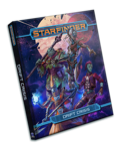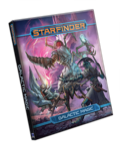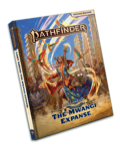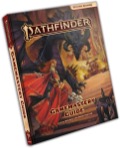Sign in to create or edit a product review. Drift Crisis is without question the strangest book in the Starfinder lineup - possibly even in Paizo's entire publishing history, if not in the history of tabletop RPGs in general. Seasoned TTRPG players might think of it as 'metaplot' (though Paizo themselves likened it more to a comic book crossover event), but there are a number of key differences that distinguish the Drift Crisis from the likes of Time of Judgment (World of Darkness) or the End Times (Warhammer Fantasy), or even aforementioned comic book crossovers. But novelty alone does not a great roleplaying game supplement make, so how does Drift Crisis hold up? So what even is this Drift Crisis? It’s simple, really: the Drift, Starfinder’s hyperspace and default means of FTL travel, suffers an unexpected catastrophic failure - first in the instantaneous Drift Crash, and in the ongoing Crisis that follows. However, with the sheer importance of the Drift to trade, travel, military strategy, communications and even faith, every strata of galactic society is affected - and in turn, every type of Starfinder adventure. The Drift Crisis is, above all else, a toolbox for storytelling, a surprisingly flexible one at that - although there is a canonical cause and conclusion that Paizo themselves are sticking to in this and other upcoming products, the bulk of the material works just as well if you diverge from the canon (indeed the book even encourages this to some extent). In fact, there isn’t even a default start date like you’d expect with a typical metaplot event - you could have your campaign start off pre-Crisis and only introduce it midway into your usual Adventure Path (more on this later), and you could just as easily start things off with a brand-new adventure that takes place with the Crisis well underway, using one of the many provided adventure seeds that constitute the bulk of the book. There is 20 of said adventure seeds, which vary in length (between 2 and 6 pages each), cover a wide range of levels (a few can go from 1 to 20!), and in some cases can be chained together (with advice on a few possible arcs presented at the start). Each one features a general outline of possible events, as well as NPCs, creatures, factions and locations involved. Most also have a few new player options (which might be given out as rewards for the adventure, or used independently), and there is a new creature in the back associated with each one. They’re less detailed than a typical standalone adventure or Adventure Path, and this can be either a boon if you enjoy filling in the blanks to suit you and your group, or it can be a little intimidating if you’re a flaky GM like me. Regardless, they are very actionable tools that can help you bring the Drift Crisis to the table, which is the main thing that matters in a book like this. While the canonical Crisis will be resolved (sometime next year with the Drift Hackers Adventure Path), it may damn well never end in your home game if you so desire, or you might end up with a very different set of consequences once it does resolve. Paizo has even provided reasonably detailed advice on adapting almost every already-existing Adventure Path to take advantage of this book, some of which can pretty radically alter the feel of the APs, and might reincorporate material published in this and other Starfinder books. Which leads me to another strength of this book - very little of it is about resolving already-existing conflicts or killing off your favorite NPCs, the way that some metaplot-style books in the games of yore might have. While a few corner cases may be slightly invalidated due to the shift in circumstances, the vast majority of what’s on offer here only exacerbates, complicates, and overall enhances the already-presented story hooks scattered throughout the rest of the game, while obviously creating a whole host of brand new ones. You get references to all sorts of already-published Starfinder products, and not just the expected hardcovers - a number of Adventure Path issues and even an organized play scenario get a shoutout here, which can be either great payoff if you have a large collection of Starfinder materials, or it might feel a little annoying to have to hunt down disparate products like that. Your mileage may vary, but I for one enjoy when a game remembers to reincorporate stuff published earlier in its lifespan. Not only that, but because of its global scale, the Drift Crisis serves as excellent connective tissue for what in the past might have been rather disparate areas of the setting - everything feels a lot more dynamic and interconnected, and although you can still just as well run a self-contained story that doesn’t touch on the greater ongoings of the Crisis, you get a much richer and livelier backdrop to do so against now. It wouldn’t be a hardcover Starfinder book without some new player options, and there’s all sorts to be found here - although not every class gets dedicated toys here (sorry, soldiers!). For those concerned that the new options are only relevant to the Drift Crisis (and might not be of use to those not interested in the Crisis, or are worried they’ll be outdated once it’s resolved), fear not - most of them, while thematically linked to it, work just as well outside of its context, whether that’s the class options (like the Drift connection mystic), the equipment, or the spells. They are somewhat scattered, with a solid chunk in chapter 1, and then sprinkled throughout some of the adventure seeds in chapter 2, but thankfully there is a nice index in the back that collates them all, and it will all eventually be on websites such as Archives of Nethys or the Hephaistos character builder anyway. A few final miscellaneous points that I didn’t have a great place to mention elsewhere: - The art is, as always, top notch. Starfinder’s art direction has always been one of its strongest points, and it shines bright as ever in this book. Some fan-favorite species make an appearance here (check out the shield-throwing vlaka on page 48!), and we finally get a look at what Drift beacons look like in here. -There is a section further describing the Drift as it exists before the Crisis, which will be universally useful even to groups opting out of the Drift Crisis storyline. - The final chapter has rolling tables for treasure you might find, generally in the wake of the Crisis, either to sell for credits or to use as further story hooks. If you’re a fan of this stuff and you felt that Starfinder was missing genre-appropriate loot tables, you will enjoy this one. - There is a section on concluding the Drift Crisis and what consequences it might bring to the larger setting moving forward. It’s not immediately clear which of these will become ‘canon’ (though I have my own suspicions), but at least a few of them could be really interesting moving forward (or even just in your home game). So keep an eye out on the Drift Hackers AP in 2023. Sometimes it can feel as though Starfinder exists in the shadow of Paizo’s bigger game Pathfinder, but Drift Crisis proves that there is a very passionate team still hard at work on this d20 science-fantasy RPG, and Starfinder isn’t going anywhere. It’s a revolutionary approach to a setting book, and it will be interesting to see how it affects the game as time goes on. So, full disclosure: I have a huge bias towards the -fantasy part of science-fantasy: fighting demons in space is significantly more appealing to me than with an alien species, and I'm still dying for a deep dive on the planar cosmology in Starfinder, though mixing all that with high tech is great, and part of the charm to begin with! Tech Revolution was fun and all, especially in the worldbuilding department, but I've been absolutely PUMPED for this book since the moment it was announced; now that it's actually here, how does it hold up to those expectations? On the whole, pretty great! There’s a few rougher points and blemishes to be sure, but taken as a whole it’s a huge net positive for the game, especially if you, like me, felt that the game has been tech-dominant for the most part (a fact that’s diegetically addressed in the book itself to an extent; Pact Worlds do have a soft tech bias). So here’s a breakdown of what’s in store: - The new precog class, and new options for all other classes.. There’s some slightly questionable design decisions to this one when it comes to its power level relative to other spellcasters (start with proficiency in advanced melee/longarm/sniper weapons, and eventually being able to get full base attack bonus scaling is…a little much, Paizo), but conceptually it’s a fun class that delivers the chronomancy fantasy without being really hard to adjudicate, and something of a counterpart to the witchwarper in my opinion. Might warrant some errata or houserules, though.
- New items, whether strictly magical or hybrid. A particular standout here not mentioned in other reviews so far are gimmicks, which let spellcasters customize their spellcasting, both aesthetically and mechanically, akin to spellcasting foci (or metamagic rods, specifically) of old; They come in a variety of options, and some can make all those lower-level spells whose DCs just become laughable actually stay relevant throughout the game - and that’s on top of the flavor of having a cool sci-fi magic wand or what have you. A real gamechanger. Also included are some new serums, weapon fusions and armor upgrades, and three new artifacts. Overall, lots of great options, whether you’re a player looking to fine-tune your spellcaster’s build, or are a GM looking for fun and quirky new rewards to give out (the trench coat of utility is fun!). - 100+ new spells, ritual rules, and spellcasting variant rules. The de facto main course of the book, there’s roughly 20 pages of new spells for all classes, including those for the new precog class. Many of those spells fill previously under-represented niches, like variable-level spells, offensive touch spells, barrier spells, and so on. I do wish the witchwarper received some unique spells (unlike the other classes, which all receive at least a handful of spells exclusive to their spell list), but that’s a somewhat abstract concern.
- Information on religion, gods and philosophies in the Starfinder setting. Moving onto the more narrative-oriented section of the book, though there are still some rules bits here - notably, a way to swap out your character theme’s default theme knowledge with that corresponding to your deity, as well as a feat for gaining proficiency and some other minor benefits with your deity’s favored weapon.
- Finally, a chapter on magic in the galaxy. To some, this will be just a lore-dumpy snoozefest, but to me, this is my favorite section of the book. First, we get a look at what stages of development magic generally goes through in the galaxy, how it functions, what its general limits are, what kind of career a magic user might undergo, and how they’re perceived in society. It’s a bit on the abstract side perhaps, but at the same time, really helps clarify magic’s role in the setting, providing some solid guidance on how the four different spellcasting classes are perceived and how they function, which is hardly useless. The following two sections are much more concrete however, discussing various magic institutions and magical factions in the Starfinder setting, from the familiar ones like the Arcanamirium, the Hellknight Order of the Gate and the Xenowardens; to brand-new ones such as the nefarious mind magic-oriented Palace Obscura academy and the Eldritch Games League. The last section of the book is titled Magical Phenomena, and it describes a number of large-scale ways in which magic manifests, parallel to how real-world physics result in black holes or nebulae. And here, there’s some truly fantastical things, from alignment singularities to Drift thinning (with an ominous potential teaser towards the upcoming Drift Crisis? Who knows), to metastars that radiate magic (including a nod to the Starfinder adventure Liberation of Locus-1, which is a nice touch) and wormgates that, like wormholes, link different planes. Overall, this chapter is full of absolutely great and creative stuff that alone can spawn dozens of quintessential science-fantasy adventure ideas, be they serious or silly or anything in-between. With Galactic Magic, I finally feel as though Starfinder’s fantasy side will be able to flourish like never before. Stuff like this is - the unabashed embracing of the blend of speculative fiction tropes and ideas - what makes it distinct from other sci-fi properties like Traveller or Star Trek or Star Wars or The Expanse, so if that kind of thing appeals to you, it’s a very valuable grab. Some extra things that didn’t fit into other sections:
If you want the short version: this is the best lore-oriented book Paizo has ever put out. If you have any interest at all in the subject matter, get it, you won't be disappointed. For the longer version: Written from the perspective of the locals by a majority-Black team of awesome designers, this book portrays a rich and distinct take on the Mwangi Expanse, Lost Omens' Subsaharan Africa-inspired region, one of the ten meta-regions outlined in previous PF2 sources such as the Core Rulebook and World Guide (and sometimes talked about in earlier 1st edition sources). The Mwangi Expanse has had a rough history in terms of its portrayal in Pathfinder - but in turn so did any African-inspired region in fantasy games, literature, and then in turn so did portrayals of real-world Africa. It's usually shown as a land of (and I hate using these words) 'savages' who "pose a threat" to "civilized society"/'adventurers', and it's a whole nasty, icky, gross thing I don't need to get into further - because luckily, this book bucks all these past trends, and does so in style! It's a 300+ tome full of great lore and stunning art (easily some of the best in all of Pathfinder), though if you're in it strictly for player options and rules, you might be a little disappointed - apart from the new playable ancestries and monsters, there's very little mechanical content sprinkled throughout the book, most of which should be/is freely available online. The book opens up with a broad overview of the region, including thoughtful advice on how to make characters who are either native or foreign to the place, as well as how to treat it with the respect it deserves. Next up is a history section, going all the way back to the ancient, murky history, to recent affairs. Several base ancestries are present and reimagined through an African lens, including humans, three distinct elf cultures (each battling a 'Great Darkness', which they all believe to be different things), two distinct dwarf ones (each with a particular affinity for the primal cloud dragons), the nomadic and secretive halflings, respected demon-slaying orcs, and others, such as the astrologer lizardfolk.
Honestly if anything, the new ancestries are ever so slightly less interesting than the reframed classic ones (mostly coming down to pagecount and overall lower integration with the rest of the book outside of their respective ancestry entries - hardly a dealbreaker though, they still rock). Next up is a section on religion, including several new gods (such as the god of Being Big, or the tyrannical child-mummy sun god, or the trio of old sun gods he banned the worship of in the city-state he rules) - good stuff that can inspire all kinds of characters and stories, and not just in the realm of clerics and champions. Following that is the geography chapter, which covers both several natural regions (jungles, mountains, savannahs, magic hurricane-flooded shores) as well as polities - ranging from the city-state of Nantambu which hosts the world's oldest magic academy of Magaambya to Bloodcove, a hideout for seedy merchants and pirates alike, to Vidrian, the former colony that recently went through a revolution and is still establishing itself on the political scene. Last but not least is the bestiary section, which not only adds several new beasties to encounter, but also suggests which creatures from previous Pathfinder material can be incorporated into a Mwangi campaign. The campaign potential in this campaign is almost endless - each page is just bursting with adventure and character hooks, and together they add up into something of genuine beauty, and you can tell that this entire book is a product of love, passion and joy - and it's such a significant step-up from Paizo's own previous attempts at showcasing the Mwangi Expanse. By throwing out the old colonialist tropes and eurocentric approach and handing over the reigns to Black writers and giving them a platform to tell their fantasy stories, this is, bar none, the best setting book currently in Paizo's lineup, if not in the whole industry. Kudos to the entire team that worked on this, from the writers to the artists to the editors and developers, and I deeply, deeply hope we can see more books that take this approach when writing about non-European-inspired regions in the future - because that would be simply awesome. So I'm a rather fledling GM, both within the Pathfinder sphere and the broader world of tabletop, and I'm not one to run prewritten APs or modules, and I'm always eager for more books (or sections of books) that cover how to run games - and from that perspective, the 2e Gamemastery Guide is fantastic. Going section by section:
To some, it might seem like "well, duh" - and even to me these concepts weren't alien going in, but it's extremely great to see those tackled in a hardcover mainline rulebook for a major RPG and not merely on places like Reddit.
- Tools is the next section, and it's a fun one for sure, one that a lot of people out there will benefit from - featuring an extensive coverage of creating monsters, hazards and NPCs (with the caveat that it's still more of an art than a science, even in a crunchy game like Pathfinder), various kinds of magic items (intelligent, cursed, relics, artifacts) with guidance on how to make your own, and a solid section on worldbuilding, for those who wish to run Pathfiner in a setting of their own. - Following Tools is the Subsystems chapter, which might be one of the best parts of the book - starting off with a breakdown of how most subsystems operate and how to make one of your own, followed by several sample ones, from Influence for more robust social encounters to "Hexploration" (couldn't it just have been called Hexcrawl though?) to Afflictions (which seem to be handled with a decent amount of tact, given the kind of subject matter it is) to Vehicles! Certainly a lot of fun stuff here - my head is already buzzing with how to utilize a lot of these, or even make some myself! - Next up on the list we have the Variant Rules, which allow you to tweak the game under the hood to tune it for different sorts of tones and genres - want less reliance on magic items? Boom. Want a grittier game that resembles 5th edition more, without the level bonus to proficiency? Got you covered. Want gestalt PCs with multiple classes? That's in there. - Last but not least is the NPC gallery, which sounds like what'd you expect - essentially a bestiary of NPC stat blocks, divided into various categories like Criminals and Explorers, with plenty of advice on how to utilize and modify them, nicely complementing the Monster/NPC creation chapter as well as the Bestiary. Also the art is very nice and decently diverse. Overall, I'm very pleased with this book, and certainly see myself getting a solid amount of mileage out of it. Kudos to Paizo for this one! This is probably my single favorite Starfinder book so far - a lot of great options here, from the new classes, to new and alternate options for the existing classes and species, to all the other bits and pieces. I'd say that right after the CRB, the first Alien Archive and Armory, this is essentially a must-have. There's some issues that would benefit from being errata'd, and the book can feel a bit short for some people's tastes (especially if you're used to the lengthier Pathfinder volumes that cover this sort of ground), but as far as what is in the book, it's a highly valuable resource indeed. |









